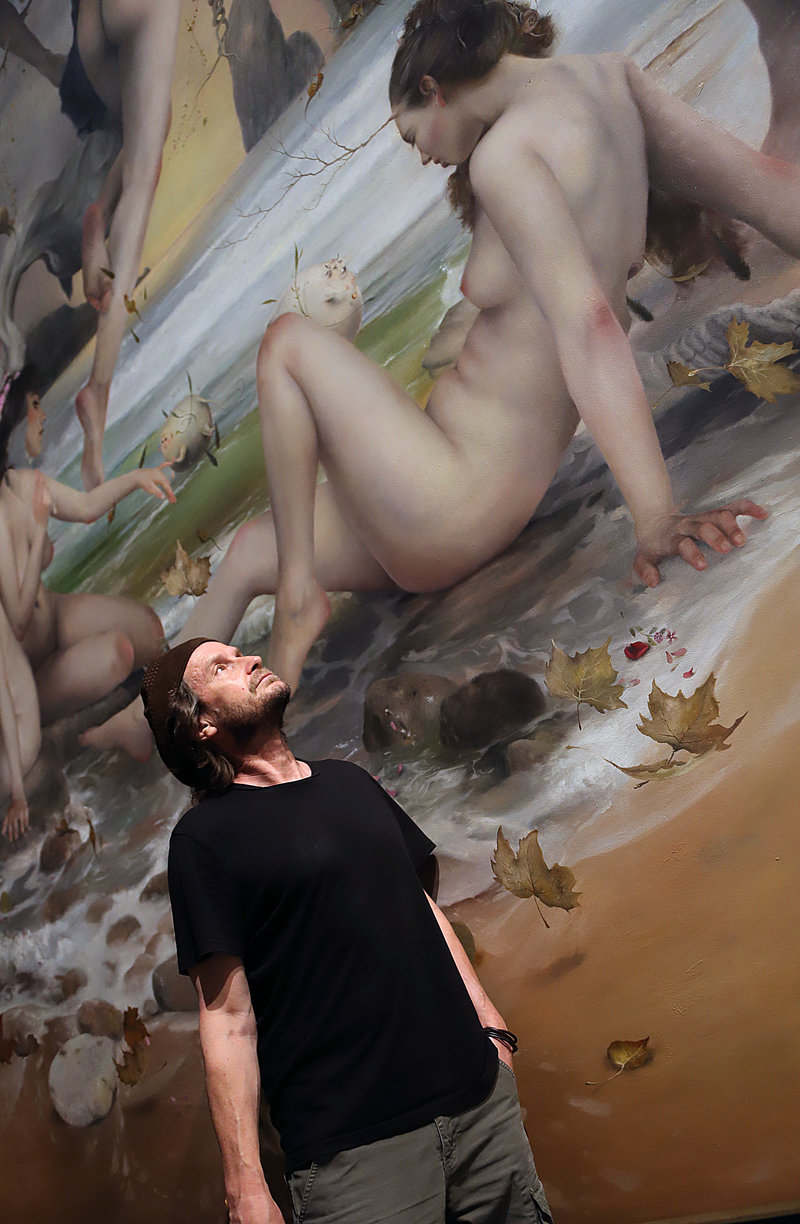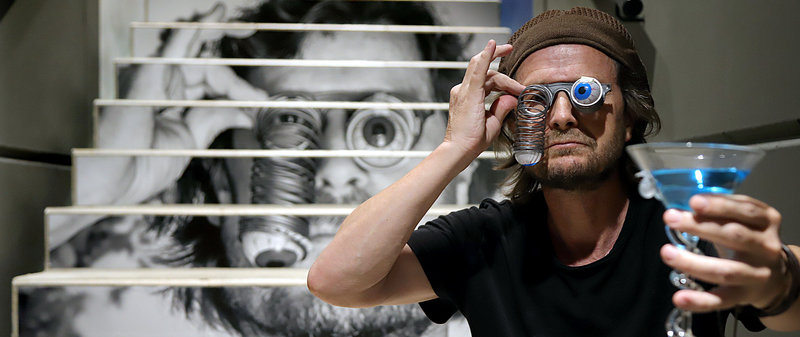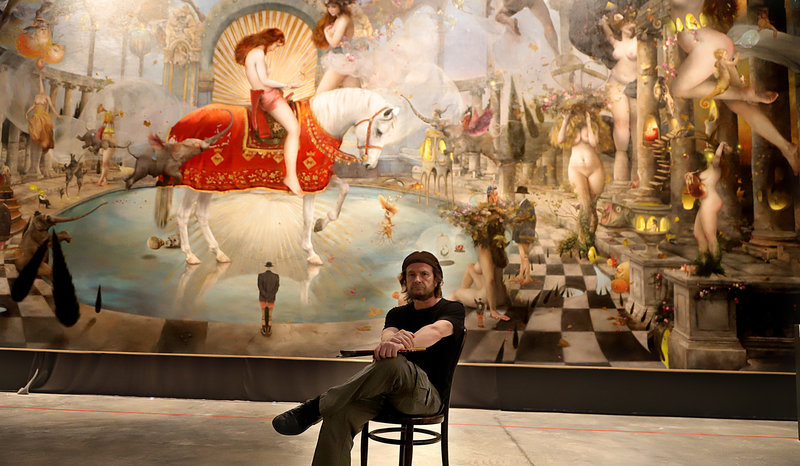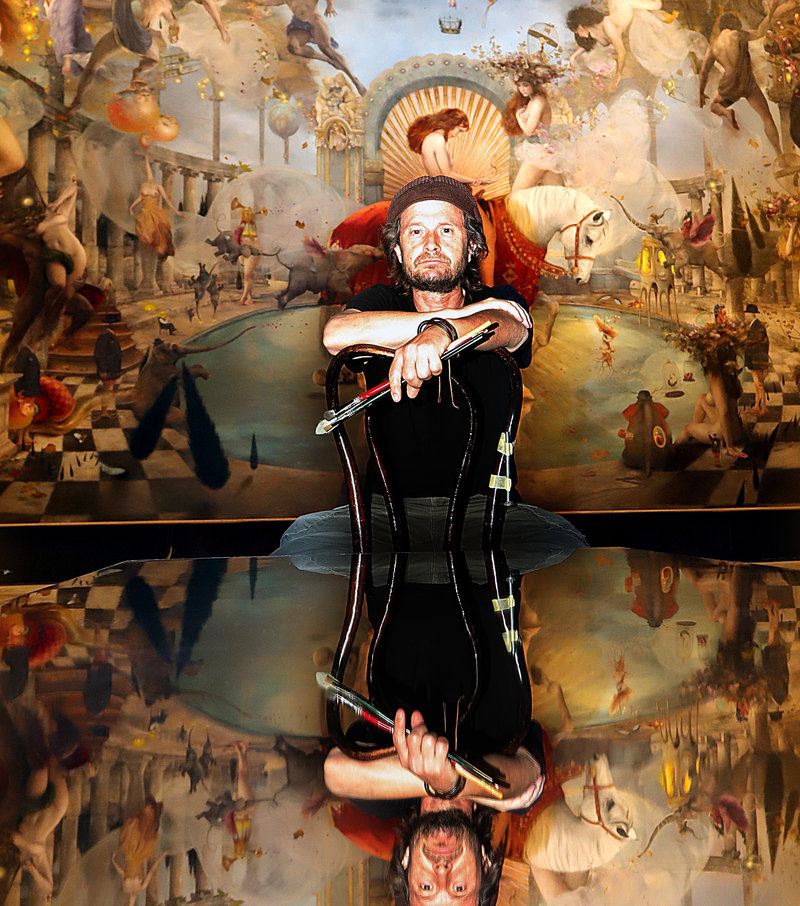How did the lockdown go, was it profitable and productive?
It happened that I’d just started painting La Llibertat, the third part of the trilogy of the visual manifesto of Strambotism, when the Covid crisis started. So I stayed here to paint exclusively. I had this time for me alone with no distractions. I was shut in here in my studio day and night. It was very useful for me to make progress with the painting, so the lockdown was a good thing for me.
What is Strambotism?
Strambotism is the only artistic trend that was ever born in Catalonia, probably in the Iberian peninsula and even Europe, in the past 100 years. It is an artistic movement created by the painter Joan Fuster. He is the father and I am the mother of Strambotism. It is unclassifiable and indefinable, because art is subjective, art is a mirror of our consciousness, art cannot be defined, you can’t put it in a cage. I’d like everyone to have their own perception of Strambotism. Strambotism didn’t invent a new way of understanding art, or redefining art, but is imagination in a pure state. It’s not being afraid of making use of the imagination we had as children. At the epicentre of Strambotism is the imaginatio and the muses that we all have. But as we grow old we forget the muses or stop listening to them. Strambotism has to do with seny i rauxa [the Catalan cultural concept containing the opposition of ’good sense’ and ’wild abandonment’], it is a hyperbolic imagination that changes your environment, changes the functions of the things around you, it’s imagining an altered reality, but with the right amount of seny so that this can have a creative result. Strambotism is when normal people do things that aren’t normal. For example, a butcher who wants to make sausages but realises he doesn’t have any salt, and instead of saying ’I’ll wait, I can’t make sausages’ he decides to put sugar in instead and invents botifarra dolça. By the way, if instead of a Catalan he were an American, the whole world would now be eating it. Strambotism is when you have that impulse and do things that you always wanted to do. Many people are afraid, but one day they say that’s enough, I’ll go for it. A cyclist who goes on a bike tour around the world, that’s also a strambotic act. Strambotism is 99 per cent rauxa and one per cent seny. But that one per cent needs to be there, because if not, rauxa becomes self destructive.
What is your role as the heir of Strambotism?
Here at La Fortalesa in Sant Julià de Ramis, at the DOR Museu, is the Quim Hereu space, which is where I work and where I have my studio, from where I am doing the trilogy: El Temps, El Poder and La Llibertat, which is the visual manifesto of Strambotism . My intention is for this space to become the sanctuary of Strambotism in time. Now my most urgent aim is to finish the trilogy, and then I want to make the Llegendarium, the sculptures that will decorate the exterior.
When and how did you get in touch with Strambotism?
When I was little boy, I used to draw at the house of my aunt Conxita in Girona, while preparing my afternoon snack, she used to ask me “why do you make these strambotic drawings?”. I didn’t realise it at the time, but she already had a premonitory vision. Thirty years later, they tell me there is this painter in Estartit-Torroella, where I also have family, who invented something called Strambotism applied to art. A mutual friend introduced us, and a very intense personal and artistic relationship was born. Something clicked in my head, the piece that was missing. I remembered my aunt, and thought: “Now I understand what she meant, and this man started it”. The thing is, he was 90 at time. He had this great idea, but there wasn’t much done – he was selling well other kinds of work, water colours, landscapes... A little after we met – we only coincided for five or six years – he called me one day and asked me to go to Alquimia, his studio in L’Estartit. He told me: “I am going to die, and I am making you the heir of Strambotism; you have to finish what I have started”. I said yes, although I have never been interested in becoming a “professional” artist or anything that ends in an -ism. But I thought either I have absolute freedom or I don’t want to have anything to do with it. I had no interest in the artistic commercial circuit, or art galleries. I knew from artist friends that in the world of art, the commercial part prevails rather than authentic creativity. That’s why I wanted to do something different in order to be free to paint what I want and not depend on anything else.
So, ...?
Like John Lennon once said: “Life is what happens to you do while you're busy making other plans”, so I had a plan but life had other plans for me. I met Joan and discovered the world of patronage. We need to update this concept. Today, a patron is a normal person with a great sensitivity for art. Joan, the person who has accompanied me from the beginning, is a lawyer from Mallorca who has been living in Mexico for many years. A patron is important because it gives you the freedom to do what you want. A lot of patronage doesn’t work because there isn’t total authenticity. I’ve always said that the relationship between painter and patron has to be like that of a couple, with dedication and absolute trust. When there is this magic, this relationship can be eternal, an indestructible block, for me it’s the basis of creativity. Then I met Ramon, my second patron, when I was halfway through the trilogy, and he proposed that I become part of his project here at La Fortalesa. Sr Ramon is a clear example of Strambotism: he is a successful entrepreneur in jewellery but, despite everything, he decided to make his dream reality, and this is a strambotic impulse. We created the Quim Hereu space here. This space was created taking into account all of the strambotic ideology.
The chef Jordi Cruz runs a restaurant at La Fortalesa, does he also apply Strambotism to his dishes?
Jordi and I built a beautiful friendship, and we also coincided at a creative level. He applied the Llegendarium, the metaphors that define Strambotism, to cuisine, he translated them into dishes and gastronomic forms. It’s marvellous when people apply it to their field – that can be the case of a painter, sculptor, butcher, entrepreneur, or factory worker; we are all a bit strambotic. For example, at his restaurant you can order: pets celestials, they are delicious, made in a Korean pot, like a mousse. The pet celestial transports you to the happiest moment of your life! Or the snails of eternal youth; people eat them and become young, they allow you to control time. Also, you can have soup of human consciousness, flying cypresses, textures of branch men, and Strambotism itself, all served in special dishes, chairs, tables, and so on. You can order a strambotic feast or hold an event, we’ve done a few.
Are there any artistic movements or artists that inspire you?
All we are is the result of what we have seen plus what we can humbly bring. Since I was little, I’ve had Stendhal syndrome when I see certain paintings. One of the painters that most inspired me is Hieronymus Bosch, I think he might have been the first strambotic artist in history. There is a series of painters who influenced me enormously: William-Adolphe Bouguereau, a French academic painter with a prodigious technique, Paul Delvaux, Georgio de Quirico, and of course Dalí... I don’t indentify myself with Surrealism, Impressionism, Puntillism, Cubism, or any other trends in art history books. Strambotism was born because I was seduced by the idea of developing an artistic movement born in Empordà, started by a man I knew in Estartit, a place I so identify with.
El gran dia de Girona by Martí Alsina was the biggest painting in Catalan art until you came along.
Yes, but it was by chance; I never meant to beat records. My three pantings in the trilogy are 12 x 6 metres, that’s 72 square metres each painting. When Fuster made me his heir, the first thing I thought was that we need a manifesto, to explain to people what Strambotism is, and I thought of three large format paintings. To make it more strambotic, the size of my studio was 10 x 5 metres, so I decided to make them bigger than that. When I started this trilogy, I didn’t even know how big Martí Alsina’s painting was. I had already started mine when they brought it to Girona, and then someone called me to say I was painting the largest painting in Catalan painting, as it was larger than his, but for me that is not important.
Let’s talk about the three paintings: El Temps, El Poder and La Llibertat.
In the Strambotic Birth of Venus, or The Time Factory, started in 2008 and finished in 2012, the central figure is the icon of Strambotism, Venus, the goddess of carnal, explicit love, but with the head of a cow. By the way, it’s a Bruna dels Pirineus breed of cow, from near Baget, I find they have an almost human look. Venus is the central figure, but not the protagonist. The main figure is the Time Factory, a woman who is giving birth to the snails of eternal youth, who allow you to buy time.
The three paintings are full of metaphors and repeated symbols.
Apart from the head of Venus and the snails, there are the branch men – who have an excess of seny, which annuls you, they are paralysed by fear, that’s why they are always still in the same place and will never succeed in doing anything they want. The balloon men, are the ones who lost this capacity to imagine and can’t listen to the muses any more. That’s why they have short legs, eat too much, and float in space without purpose. All the characters in the painting are in search of eternal youth.
What about the second one, La coronacio d’Ermessenda?
There are many forms of power: military, economic, political, ecclesiastic, but Ermassenda de Carcassone, who lived a thousand years ago, was the first queen of the Catalans and at a time when everything was resolved with swords and violence; an apparently fragile woman had great power in Europe. Why did she have such great power? Because of what she is holding in the painting: a snail of eternal youth. Her lands reached to Empordà, where she discovered snails from the Time Factory, and she learnt how to exchange time for favours and power.
And the last one deals with freedom.
Llibertat is different from the other two: it is darker and light plays a big role. It takes place inside the cathedral of Girona. I took the roof off the apse and the light that had never entered for a thousand years bursts in the central part of the painting and I play with different spots of light illuminating different characters. Why freedom? Because neither time or power make sense if you don’t have freedom. Hopefully I’ll finish it this year and then concentrate on the Llegendarium sculptures.
Do you still have time for other projects?
We’re preparing a long feature film about Strambotism. I’m very excited about it. I enjoy helping with the scriptwriting process, which among other things also reflects on and deals with the duality of the creative process – the temptation of doing what is required commercially or what makes you feel good, what you want and what others want from you. That’s a complicated duality that many can’t resolve, a drama that I have and many have. I live with a permanent conflict – when Fuster made me his heir, it was almost a sentence, because you have to stay away from any commercial option. I can’t make small works; I’ve been painting large format works for 12 years. It’s a sacrifice on a personal, artistic and economic level, that’s why sponsorship is so important. www.quimhereu.com www.lafortalesa.com
interview Quim Hereu








